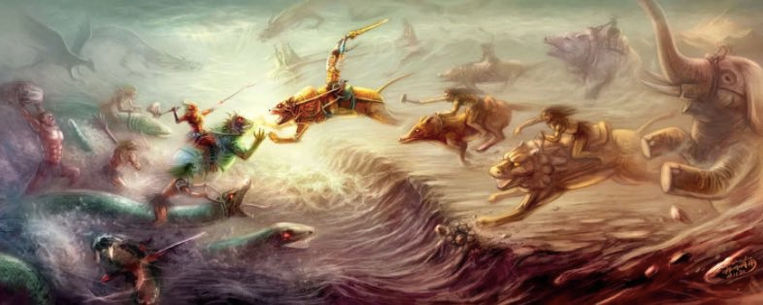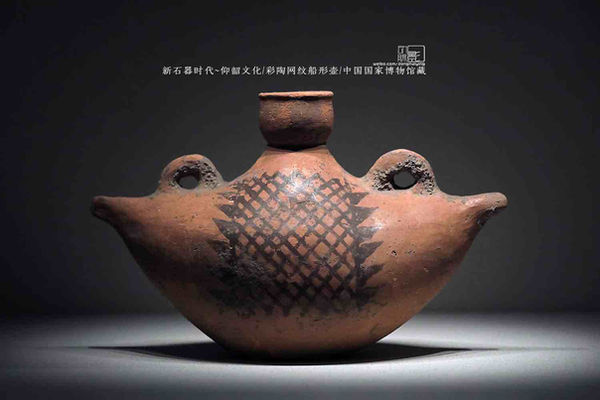Yellow Emperor or Huang Di (about 2717 BC — 2599 BC), named Gongsun Xuanyuan, also respected as Xuanyuan Huangdi, was an influential figure in Chinese culture.
Together with his brother, the Flame Emperor (Yan Di), they are respected as ancestors of the Han People, the majority ethnic group of Chinese.
Yellow Emperor (Yellow represents the earth in the Five Elements Theory) was an exceptional Neolithic sovereign that defeated many primitive tribes through wars and established a united country in ancient China.

Painted Pottery Basin with Human and Fish Patterns of Yangshao Culture (Around 5000 BC — 3000 BC), Believed the Same Time and Place that Huangdi had Lived — National Museum of China (Photo by Dongmaiying)
As a cultural hero, he and his officials made significant contributions to inventing or developing Chinese Medicine and the ancient calendar, cultivating more species of food and animals, producing clothes, ships, and carts, and setting fundamental etiquettes of his country.
Music, military strategy, math, and architecture were all well-developed under his reign.
Because of his extraordinary achievements, Yellow Emperor gradually apotheosized into an immortal with magical power and a mysterious ending in Chinese Mythology and Taoism Religion.

Rising of Yellow Emperor and His Tribe Youxiong
Yellow Emperor, the son of Lord Shaodian and Queen Fubao, was born a genius.
When he turned 20, he inherited his father’s tribe, Youxiong, and worked diligently to train his people and develop the economy.
He found and cultivated more types of crops and enriched the diet structure of Chinese food, tamed many wild animals, and invented numerous valuable items, such as more sophisticated weaving tools, crop devices, weapons, martial arts, and building styles.

Painted Pottery (Bo) of Yangshao Culture — History Museum of Taipei (Photo by Dongmaiying)
With more tribes being defeated, annexed, or complied, his kingdom kept expanding from the Yellow River to the Yangtze River area.
Gradually, Flame Emperor (or Yan Di) felt threatened; he and Yellow Emperor soon fought intensely three times.
This was the Battle of Banquan, in which the Yellow Emperor won and annexed the tribe of the Flame Emperor.
Their descendants formed the civilization of Huaxia (the origin of Chinese Culture), and Yan Di and Huang Di, together, became the honorable ancestors of the Chinese Han people.

Yellow River or Huang He that Cradled Yangshao Culture, Photo by Guo Ping.
Defeating Strong Lord Chiyou in the Battle of Zhuolu
Till now, most tribes were under his reign, except Chiyou.
In some documents, Chiyou was lord of a strong tribe named Jiuli in the east, while in others, he had worked for but later rebelled against the Flame Emperor or the Yellow Emperor.
Importantly, Chiyou was very aggressive, and his tribe obtained many powerful weapons.
In mythical history, within Chiyou's army, there were 81 generals, including Chiyou himself, with human heads and animal bodies, and ate nothing but stones from rivers.
They also gained assistance from the God of Wind and Rain; many ghosts and monsters were serving in his troop, helping them initiate an attack using supernatural power.

Battle of Zhuolu in Chinese Mythical History
The Yellow Emperor Huangdi was a more intelligent monarch and a better general.
He learned to produce advanced weapons from those captured weapons of Chiyou's army and invented the Southward Pointing Cart to guide his soldiers in the dense mist that the God of Wind created.
According to the Classic of Mountains and Seas, some deities of Mount Kunlun, the most powerful dragon Ying Long and the Fairy of Drought all participated in the final battle.
Together with his brave human soldiers and tamed animal fighters, including wolves, pandas, bears, and tigers, they defeated Lord Chiyou.

Yellow Emperor or Huangdi Fighting Against Chiyou, Drawn by Lexi.
Remarkable Reign of Yellow Emperor
After achieving the final success, the Yellow Emperor continued his exceptional governance. He became the most honorable sovereign, who established a basic regime with efficient administration officials and laws as the rudiment of a real country.
He and his officials obtained advanced knowledge that brought people stable, pleasant lives.
Within his realm, people followed the advanced calendar to do farm work, produce and wear proper clothes, keep livestock, apply herbs to treat sickness, construct houses and cities to live in, perform and enjoy music, and obey basic etiquettes.
Those achievements resulted from the hard work of him and everyone who lived in his realm.

Ship Shaped Painted Pottery Pot of Yangshao Culture (Around 5000 BC — 3000 BC) — National Museum of China (Photo by Dongmaiying)
In mythical history, they also got awarded by deities.
According to ancient mythical legends, a beautiful phoenix showed up in the secular world, carrying a picture that indicated the most important virtues required to be a king.
Soon, a yellow dragon sent him a magical book that included valuable knowledge regarding Chinese astrology, geology, medicine, and divination.
The Yellow Emperor passed on all his knowledge to his people and brought them a golden age.
Legendary Traveling and Mysterious Ending
Seeing that his people were living happily and peacefully, he visited immortals and asked for more helpful knowledge.
During this period, Huangdi held a worship ceremony on Mount Tai and performed Alchemy on Huangshan Mountain.

Sacred Mount Tai of Shandong Province
When he was old, he built some ritual vessels named Ding, which became an emblem of sovereign power and legal dominance in ancient China.
Right after all the Dings were finished, a dragon appeared in the sky, flew toward the Yellow Emperor, and announced that he had made outstanding contributions to the development of society and had finished his mission; it was time to go back.
After he jumped onto the back of the dragon, they disappeared into the sky.

Eagle Shaped Pottery Tripod (Ding) of Yangshao Culture (Around 5000 BC — 3000 BC) — National Museum of China
The civilization he established continued to develop and flourish over the next thousands of years.
His medical book, the Huangdi Neijing (Inner Canon of Huang Di), became the fundamental textbook of Traditional Chinese Medicine. He has been respected as an essential deity of the Taoism Religion.
Besides, many temples were built throughout history to memorize the Yellow Emperor, one of the most legendary Chinese emperors and a cultural hero.
Today, tens of thousands of Chinese people still hold grand worship ceremonies in those memorial mausoleums yearly.

Mausoleum of Yellow Emperor (Huang Di) in Shaanxi Province